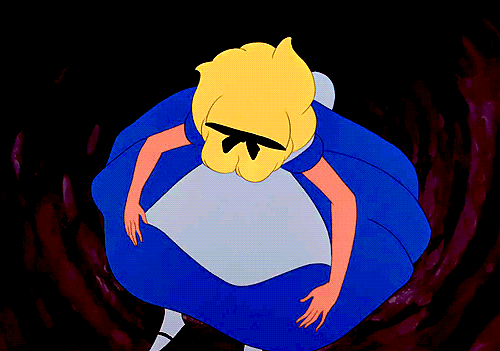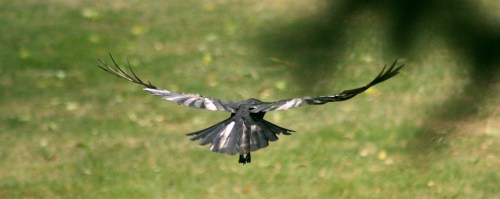Generally, when I receive emails with the subject line “interesting crow” it’s because the author noted some peculiar or amusing crow behavior they want to share, or because they spotted an unusual looking crow due to AKD, leucism or avian pox. Rarely, it’s for none of these reasons and is truly a horse of a different color. Or in this case, crow.
Meet Al, a hatch year American crow whose natal territory overlaps with Tara Chafe’s property. According to Tara, Al is the second bird born in the last 5 years with this kind of color abnormality. The bird that she reports is its mother is leucistic, but as you can see below, she’s not a particularly dramatic case with maybe only one or a couple more white feathers.

Without having observed Al myself I can’t confirm any of Tara’s observations, but from her perspective, Al appears to interact normally with the other crows, and doesn’t exhibit any other health issues. In fact, the first caramel crow that Tara encountered has gone on to mate and establish a territory in a nearby neighborhood and she still occasionally encounters it.
Understandably, Tara’s question to me was “what is going on here?” and initially, though I am by no means an expert in pigmentation, I didn’t expect it would be too much work to provide her an answer. And with that my descent began.

It’s helpful to start by understanding what controls pigmentation in birds. There are three different groups at play: melanins, carotenoids, and porphyrines.1 Melanin is probably the most familiar term, after all we possess a lot of it ourselves and the skin cancer melanoma is named for the melanin producing cells where it occurs. In fact, there are three kinds of melanin: eumelanin, which controls dark browns and blacks, pheomelanin, which controls reddish hues, and neuromelanin which occurs only in the brain. Carotenoids, on the other hand, are derived from plants and produce the red of a cardinal or the yellow of an American goldfinch. Porphyrines, which are modified amino acids, can produce a wide variety of colors from pink to green, as observed in some of the more colorful corvids such as the Bornean green magpie and ceylon magpie. Lastly, the structure of the feather also plays a role in color, particularly with respect to the color blue and iridescence, but I’ll save that for another post. Of most concern to us in this case is melanin, since that’s what’s controlling coloration in American crows.
Knowing this is an issue of melanin, I next wanted to identify how we might characterize this color aberration. Older birders will describe this bird as leucistic, and historically that convention was considered accurate. Contemporary semantics among pigmentation papers, however, have clarified leucism as a condition that “results from a complete lack of melanin from all or parts of the plumage”.2,3 In other words, crows that are leucistic would be completely white in one or more feathers, which this crow is clearly not. Without yet knowing exactly what’s going on here the more appropriate terms might be: “Schizochroism” meaning a lack of a single pigment, or “dilution” meaning an overall decrease in pigmention deposition.2 A color mutation known as “brown,” meaning a qualitative reduction of melanin, has also been proposed.3

A leucistic crow in flight
With this much information at hand, we might begin to think that this reddish/caramel colored bird has some issue with its eumelanin production that is giving way to more visible pheomelanin. The trouble is, by all accounts crows do not produce pheomelanin.3,4,5 So if crows do not produce pheomelanin what is going on here?

Fellow crow expert, Dr. Jennifer Campbell-Smith, sees there being a few possible explanations. The first is simply that we haven’t studied pigmentation across Corvus species thoroughly enough to say that crows such as American crows don’t produce pheomelanin. After all, some Corvus species, such as the brown necked raven, certainly appear to express pheomelanin produced colors. Perhaps American crows do produce a modest amount that has so far been difficult to detect, but is revealed in cases like this. Alternatively, Jennifer suggests that even if American crows don’t typically produce pheomelanin they may still possess all the infrastructure for doing so. Perhaps in cases such as Al’s, the genes that regulate such production have been turned on. As an especially interesting side note, pheomelanin is a particularly energy intensive pigment to produce, and as such, there’s evidence of a correlation between larger brain sizes (including Corvus species) and low to undetectable levels of pheomelanin6.

Brown necked raven (Corvus ruficollis) photo c/o Peter Nash
Another publication suggested that cases like Al’s are caused by incomplete oxidation of eumelanin3, but I am dubious of this paper because they claimed that corvids as a family do not produce pheomelanin, which blatantly untrue at worst or, if they meant Corvus, an egregious typo at best.
Ultimately, what I found was that rather than being a matter of a quick trip to the virtual library, an explanation for Al’s condition is currently unresolved by science. Which is probably my favorite genera of science. After all, what’s better as a scientist than embarking on the unknown or poorly understood?
Many thanks to Tara for a truly interesting crow, and for agreeing to let me share Al’s story here.
- https://academy.allaboutbirds.org/how-birds-make-colorful-feathers/
- Guay, P.J., Potvin, D.A., and Robinson, R.W. 2012. Aberrations in plumage coloration in birds. Australian Field Ornithology 29: 23-30
- van Grouw, H. 2013. What colour is that bird? The causes and recognition of common colour aberrations in birds. British birds 106: 17-29
- Lee E, Tanaka H, Wakamatsu K, Sugita S. 2009. Melanin-based iridecent feather color in the jungle crow. Journal of Veterinary Medical Science 71: 1261-1263.
- http://www.sibleyguides.com/2011/08/abnormal-coloration-in-birds-melanin-reduction/
- Galvan I, Moller AP. 2011. Brain size and the expression of pheomalanin-based colour in birds. Journal of Evolutionary Biology 24: 999-1006. DOI:10.1111/j.1420-9101.2011.02232.x





Is an unusual colored bird ostrasized by the other birds? We think we’ve seen the occasional white feather, but don’t recall a whole differently colored bird.
Currently we are feeding one who whoops in a whoop-whoop-whoop fashion.
According to Tara this bird seems to interact normally. Generally a complete leucistic of albino bird would be subordinate though.
Thank you for your wonderful posts! I live in Portland, OR and walk several miles a day. Yesterday I was treated to a chorus of crow calls from several hundred crows that had gathered in trees a few hundred feet from me. Made my day! All best, Steve Einhorn http://www.qualityfolk.com
Steve
>
Thank you for this very informative blog.
I have learned so much. I shared it on my corvid/earthling facebook page as there are many corvid lovers there that will feel the same as I.
I encountered one today in Trinity, Florida. I’d like to send you the photographs if you’d like to have them.
Hi Kelly, you can send them to kaelis@uw.edu
I have one that comes to my yard on the regular and usually with a beautiful black crow! The black has been visiting for awhile. Love them! I live by the beach between Cocoa Beach and Satellite Beach in Florida.
Pingback: Corvid Research
I’m visiting in Jacksonville Florida went to the Jacksonville ocean and saw two brown crows
Everything about them was crow size beak tail everything I’m so curious
Hi Faith were they brown like the photos in this post, or were they dark brown…more like chocolate? Hatch year birds are often very brown by the end of the season since they haven’t had their first year molt yet.
We photographed a caramel crow at our warmed bird bath this morning near Des Moines, Iowa
Cool! Do you want to share them?
We had 2 caramels and one darker one at our warmed bird bath this morning … central Iowa!
Wow, second Iowa sighting in 24 hours. Guessing these are the same birds! (See Marty’s earlier comment)
Pingback: The Science Behind Caramel Crows - Corvid Blog
I found 1 in British Columbia Canada
I just saw a white crow! It was flying with a normal colored crow. It was almost completely white except for some of its flight feathers were streaked with a light pinkish color.
Awesome!
Thanks for information. Here in Seattle we just had twin Carmel crows born in a nest in the backyard. They socialize normally, are independent and maturing rapidly. One of the parents has a white streak on it’s breast, we thought this genetics might play a role in their coloration. They are difficult to photograph together but I have some phone pics of the individuals with the adults for contrast. I will be watching to see if this is a life long condition or if it they darken with age.
Hi Dave, would you be willing to talk about this over email? If so you can reach me at kaeli.swift@gmail.com
Cheers,
Hi Dave and Kaeli! I think I may have seen your twin caramel crows! I was so worried today. A hawk, it may have been a young Cooper’s Hawk, kept trying to catch the crow. There were about a dozen other crows around and no one was sounding the alarm or seemed v.concerned. They also didn’t leave the area. This is the second time I’ve seen a hawk go after a young crow. The first time the hawk killed him. I know everyone has to eat, I was just hoping it wouldn’t make a meal out of the caramel crow.
I just took some really good photos of caramel crow in NW Seattle. I can share them with you if you’d like.
Hi Shelly, you are welcome to share them with the Corvid Research facebook page!
Thank you for this article. I also have a caramel crow ‘Sadie’ and have looked high and low for a explanation. This is the first article I have found.
Awesome!
I have been feeding a family of crows since spring, and when the youngest baby finally got its full adult plumage in October I started noticing brown and auburn tones in its feathers, no white at all though. The rest of the family are fully black. I actually found your blog because I was searching for an explanation for this, and it was interesting to read your note about pheomelanin being more energy intensive because I did notice that this bird took way longer to develop full plumage than its older sibling!
I saw one of these August 10,2021 at the Costco on Willingdon in Burnaby, BC. I thought it might be grey, but couldn’t get a really good close up. It was quite lovely, and was interacting as per usual with the other crows up on the roof. It was a young crow, based on its size. Verycool. Thanks for the info.
Just saw one of these by Commodore Park in Seattle 🙂
I have a brown crow in my neighborhood. It seems more bold than its peers.